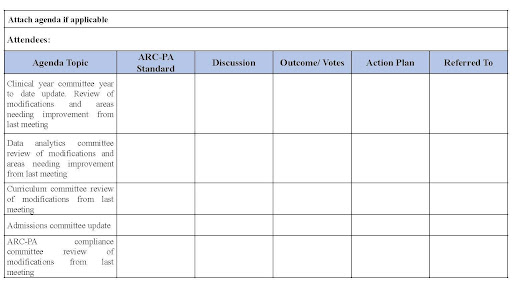ARC-PA 5th Edition Standards: Committee Minutes and Resources

In my previous blog entry, I shared my templates about forming committees to gather the large amount of data required by 5th Edition Standards for your SSR and how that data should flow from committee to committee. Now I would like to address the importance of tracking the decisions made within those committee meetings.
At an on-site visit, the reviewers will expect to see such minutes, and within the context of those minutes, they will expect to identify action plans, modifications, or areas needing improvement in the faculty minutes. This is something that sometimes breaks down because the minutes may not necessarily be up to par. The essence of the minutes may not capture the information the reviewers are looking for. I’ve seen a program that actually was determined to be inadequate in terms of critical analysis, based on the fact that they didn’t have minutes.
To ensure that your faculty’s committee minutes maintain the expected standard requires intentionality.
I include here an example of a committee minute template. A meeting agenda may be attached to this form as well as listing the attendees. I have listed a number of sample committee discussions. Now, filling in the chart should be a fairly simple matter.
- Capture the ARC-PA standard that is appropriate.
- Include the discussion that was made, but in a very succinct way.
- Include whatever the outcome or vote was.
- Capture the action plan
- Make note of to whom the matter was referred.

I want to pose some questions now, which you must ask yourself regarding your committee structure and the work that is done within in.
1. How well does your current committee structure function?
I believe that through the process of an organized committee structure, you can ensure compliance. My feeling is that this amount of organization was not necessary as recently as ten years ago. Now, with the ARC-PA 5th Edition Standards and the considerable reliance on, and expectations for, an SSR that is clearly supported by data, committee structure is vital.
2. Are you capturing critical analysis in your committee minutes?
Ensuring that your chronologically tagged minutes record action plans and modifications. Make certain that, when you have an onsite visit, you can lay your hands on those minutes at a moment’s notice and that they are easy to connect with your SSR. I highly recommend this step.
3. Do you have the manpower to gather, tabulate and generate the required data for committees to analyze?
Your data is “tied up with a bow” so the committees can do their work. Committees can’t be looking at raw data or unorganized data. That is not their function and wastes their time. When they are presented with data, all necessary computations, averages, etc. should have been made already, along with clearly labeled information and a key so the committee understands what it is looking at and can make valuable decisions based on it.
In upcoming blogs, we will break down sections of Appendix 14 and discuss the various types of data involved in each section. What data is required? It what manner can the data be displayed? And I’ll also give examples of different ways in which data can be interpreted.

